Jersey City, New Jersey, Hgh State Clinic, Hgh Injections, Hrt Doctors
Jersey City, New Jersey Blood Testing Facilities
 Represents a LabCorp blood testing facility
Represents a LabCorp blood testing facility Represents a Quest Diagnostics blood testing facility
Represents a Quest Diagnostics blood testing facility
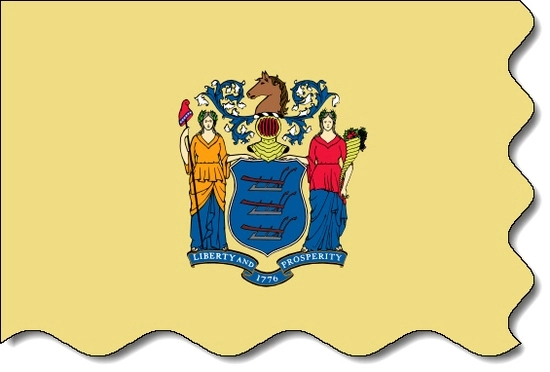
Nearby Labcorp Blood Testing facilities:
- Labcorp Center Distance: 3 m, 988 Broadway Suite 101, Bayonne, Hudson County, NJ, 7002
- Labcorp Center Distance: 4 m, 425 W 59Th St Ste 1A, New York, New York County, NY, 10019
- Labcorp Center Distance: 5 m, 115 E 57Th St Ste 620, New York, New York County, NY, 10022
- Labcorp Center Distance: 6 m, 70 East 90Th Street, New York, New York County, NY, 10128
- Labcorp Center Distance: 7 m, 240 Port Richmond Ave, Staten Island, Richmond County, NY, 10302
- Labcorp Center Distance: 8 m, 2031 Forest Ave Stes 12 13, Staten Island, Richmond County, NY, 10303
- Labcorp Center Distance: 9 m, 33-54 83Rd St Ste G-02, Jackson Heights, Queens County, NY, 11372
- Labcorp Center Distance: 10 m, 1139 Main Avenue, Clifton, Passaic County, NJ, 7015
- Labcorp Center Distance: 11 m, 2333 Morris Ave Ste A12, Union, Union County, NJ, 7083
- Labcorp Center Distance: 12 m, 1025 W Saint Georges Ave Ste 1, Linden, Union County, NJ, 7036
- Labcorp Center Distance: 13 m, 4434 Amboy Rd 2Nd Fl, Staten Island, Richmond County, NY, 10312
- Labcorp Center Distance: 14 m, 1200 Waters Pl Ste M109, Bronx, Bronx County, NY, 10461
- Labcorp Center Distance: 15 m, 1 Sears Dr, Paramus, Bergen County, NJ, 7652
- Labcorp Center Distance: 16 m, 307 Hamburg Tpke Ste 103, Wayne, Passaic County, NJ, 7470
- Labcorp Center Distance: 17 m, 313 South Ave Ste 104, Fanwood, Union County, NJ, 7023
- Labcorp Center Distance: 18 m, 984 N Broadway Ste 301, Yonkers, Westchester County, NY, 10701
- Labcorp Center Distance: 19 m, 1034 N Broadway, Yonkers, Westchester County, NY, 10701
- Labcorp Center Distance: 21 m, 3219 Us Highway 46 Ste 208, Parsippany, Morris County, NJ, 7054
- Labcorp Center Distance: 22 m, 775 Mountain Blvd. Ste 102, Watchung, Somerset County, NJ, 7069
- Labcorp Center Distance: 23 m, 2839 State Route 10, Morris Plains, Morris County, NJ, 7950
- Labcorp Center Distance: 24 m, 51 Charles Lindbergh Blvd, Uniondale, Nassau County, NY, 11553
- Labcorp Center Distance: 25 m, 297 Knollwood Rd Ste 102, White Plains, Westchester County, NY, 10607
- Labcorp Center Distance: 26 m, 40 Morristown Rd Ste 2A, Bernardsville, Somerset County, NJ, 7924
- Labcorp Center Distance: 27 m, 200 E Eckerson Rd Ste 220, New City, Rockland County, NY, 10956
- Labcorp Center Distance: 28 m, 77 Veronica Ave Ste 101, Somerset, Somerset County, NJ, 8873
- Labcorp Center Distance: 29 m, 5 Monroe St Bldg 1 Ste E, Bridgewater, Somerset County, NJ, 8807
- Labcorp Center Distance: 30 m, 83 Bridge Plaza Dr, Manalapan, Monmouth County, NJ, 7726
- Labcorp Center Distance: 31 m, 66 Town Centre Suite 310, Succasunna, Other, NJ, 7876
- Labcorp Center Distance: 32 m, 1806 State Hwy 35 Ste 101A, Oakhurst, Monmouth County, NJ, 7755
- Labcorp Center Distance: 34 m, 105 Raider Blvd Suite 103, Hillsborough, Somerset County, NJ, 8844
- Labcorp Center Distance: 35 m, 656 N Wellwood Ave Ste 208A, Lindenhurst, Suffolk County, NY, 11757
- Labcorp Center Distance: 36 m, 775 Park Ave Ste 350, Huntington, Suffolk County, NY, 11743
- Labcorp Center Distance: 38 m, 406 Route 23 Suite 2, Franklin, Sussex County, NJ, 7416
- Labcorp Center Distance: 39 m, 1985 Crompond Rd Bldg B, Cortlandt Manor, Westchester County, NY, 10567
- Labcorp Center Distance: 40 m, 254 B Mountain Ave Ste 104, Hackettstown, Warren County, NJ, 7840
- Labcorp Center Distance: 41 m, 2171 Jericho Tpke. Suite 200, Commack, Suffolk County, NY, 11725
- Labcorp Center Distance: 42 m, 57 E Main St, Bay Shore, Suffolk County, NY, 11706
- Labcorp Center Distance: 43 m, 1 Westcott Dr Ste 201, Flemington, Hunterdon County, NJ, 8822
- Labcorp Center Distance: 44 m, 150 Islip Ave Ste 9, Islip, Suffolk County, NY, 11751
- Labcorp Center Distance: 45 m, 2 Brooksite Dr, Smithtown, Suffolk County, NY, 11787
- Labcorp Center Distance: 46 m, 814 River Ave, Lakewood, Ocean County, NJ, 8701
- Labcorp Center Distance: 47 m, 1770 Motor Pkwy 2Nd Fl, Hauppauge, Suffolk County, NY, 11788
- Labcorp Center Distance: 48 m, 35 Beaverson Blvd Bldg 10, Brick, Ocean County, NJ, 8723
- Labcorp Center Distance: 50 m, 2500 Nesconset Hwy Ste 30-31, Stony Brook, Suffolk County, NY, 11790
- Labcorp Center Distance: 51 m, 448 Temple Hill Rd, New Windsor, Orange County, NY, 12553
- Labcorp Center Distance: 52 m, 46 Route 25A Suite 2, Setauket, Suffolk County, NY, 11733
- Labcorp Center Distance: 53 m, 9 Mule Road Suite 12, Toms River, Ocean County, NJ, 8755
- Labcorp Center Distance: 54 m, 5 Hudson Valley Profess Plaza, Newburgh, Orange County, NY, 12550
- Labcorp Center Distance: 55 m, 325 Middle Country Rd Ste C, Selden, Suffolk County, NY, 11784
- Labcorp Center Distance: 56 m, 108 Lacey Rd Ste 38, Whiting, Ocean County, NJ, 8759
- Labcorp Center Distance: 57 m, 411 Coventry Center Dr Bldg400, Phillipsburg, Warren County, NJ, 8865
Nearby Quest Blood Testing facilities:
- Quest Center Distance: 0 m, 2854 John F Kennedy Blvd, Jersey City, Hudson County, NJ, 07306-4014
- Quest Center Distance: 3 m, 139 Centre St, New York, New York County, NY, 10013-4552
- Quest Center Distance: 4 m, 247 Third Ave, New York, New York County, NY, 10010-7454
- Quest Center Distance: 5 m, 115 E 57Th St, New York, New York County, NY, 10022-2100
- Quest Center Distance: 6 m, 210 E 86Th St, New York, New York County, NY, 10028-3003
- Quest Center Distance: 7 m, 653 Forest Ave, Staten Island, Richmond County, NY, 10310-2517
- Quest Center Distance: 8 m, 1460 Victory Blvd, Staten Island, Richmond County, NY, 10310-3914
- Quest Center Distance: 9 m, 651 Willowbrook Rd, Staten Island, Richmond County, NY, 10314-6809
- Quest Center Distance: 10 m, 1896 Morris Ave, Union, Union County, NJ, 07083-3535
- Quest Center Distance: 11 m, 2627 Hylan Blvd, Staten Island, Richmond County, NY, 10306-4320
- Quest Center Distance: 12 m, 136-20 38Th Ave, Flushing, Queens County, NY, 11354-4277
- Quest Center Distance: 13 m, 3733 Richmond Ave, Staten Island, Richmond County, NY, 10312-3856
- Quest Center Distance: 14 m, 16624 Jamaica Ave, Jamaica, Queens County, NY, 11432-5241
- Quest Center Distance: 15 m, 189 Elm St, Westfield, Union County, NJ, 07090-3145
- Quest Center Distance: 17 m, 105 Stevens Ave, Mount Vernon, Westchester County, NY, 10550-2680
- Quest Center Distance: 18 m, 970 N Broadway, Yonkers, Westchester County, NY, 10701-1310
- Quest Center Distance: 19 m, 150 Lockwood Ave, New Rochelle, Westchester County, NY, 10801-4916
- Quest Center Distance: 21 m, 50 Cherry Hill Rd, Parsippany, Morris County, NJ, 07054-1101
- Quest Center Distance: 22 m, 165 North Village Ave, Rockville Centre, Nassau County, NY, 11570-3701
- Quest Center Distance: 23 m, 37 Mountain Blvd, Warren, Somerset County, NJ, 07059-2622
- Quest Center Distance: 24 m, 276 E Main St, Denville, Morris County, NJ, 07834-2646
- Quest Center Distance: 25 m, 280 Dobbs Ferry Rd, White Plains, Westchester County, NY, 10607-1900
- Quest Center Distance: 26 m, 1 Anderson Hill Rd, Bernardsville, Somerset County, NJ, 07924-2320
- Quest Center Distance: 27 m, 601 W Union Ave, Bound Brook, Somerset County, NJ, 08805-1166
- Quest Center Distance: 28 m, 49 Veronica Ave, Somerset, Somerset County, NJ, 08873-6802
- Quest Center Distance: 29 m, 151 N Main St, New City, Rockland County, NY, 10956-3851
- Quest Center Distance: 30 m, 978 Route 45, Pomona, Rockland County, NY, 10970-3528
- Quest Center Distance: 31 m, 146A Manetto Hill Rd, Plainview, Nassau County, NY, 11803-1323
- Quest Center Distance: 32 m, 4900 Merrick Road, Massapequa Park, Nassau County, NY, 11762-3807
- Quest Center Distance: 33 m, 333 Forsgate Dr, Jamesburg, Middlesex County, NJ, 08831-1567
- Quest Center Distance: 35 m, 260 Mounts Corner Dr, Freehold, Monmouth County, NJ, 07728-5300
- Quest Center Distance: 36 m, 83 South Bedford Rd, Mt. Kisco, Westchester County, NY, 10549-3457
- Quest Center Distance: 38 m, 1350 Deer Park Ave, North Babylon, Suffolk County, NY, 11703-1619
- Quest Center Distance: 39 m, 601 Ewing St, Princeton, Mercer County, NJ, 08540-2757
- Quest Center Distance: 40 m, 1869A E Main St, Peekskill, Westchester County, NY, 10566-2505
- Quest Center Distance: 41 m, 2171 Jericho Tpke, Commack, Suffolk County, NY, 11725-3412
- Quest Center Distance: 42 m, 791 Route 17M, Monroe, Orange County, NY, 10950-2620
- Quest Center Distance: 43 m, 8 Saxon Ave, Bay Shore, Suffolk County, NY, 11706-7036
- Quest Center Distance: 44 m, 490 Wheeler Rd, Hauppauge, Suffolk County, NY, 11788-4372
- Quest Center Distance: 46 m, 222 Middle Country Rd, Smithtown, Suffolk County, NY, 11787-2814
- Quest Center Distance: 48 m, 30 Hatfield Ln, Goshen, Orange County, NY, 10924-6766
- Quest Center Distance: 49 m, 667 Stoneleigh Ave, Carmel, Putnam County, NY, 10512-2454
- Quest Center Distance: 50 m, 233 Montauk Hwy, West Sayville, Suffolk County, NY, 11796-1811
- Quest Center Distance: 52 m, 23 Technology Dr, East Setauket, Suffolk County, NY, 11733-4069
- Quest Center Distance: 53 m, 548 Commons Way, Toms River, Ocean County, NJ, 08755-6432
- Quest Center Distance: 54 m, 1010 Route 112, Port Jefferson Station, Other, NY, 11776-2054
- Quest Center Distance: 55 m, 982 Main St, Fishkill, Dutchess County, NY, 12524-3506
- Quest Center Distance: 56 m, 555 Lordship Blvd Fl 1, Stratford, Fairfield County, CT, 06615-7156
- Quest Center Distance: 57 m, 570 Expressway Dr South, Medford, Other, NY, 11763-2049
- Quest Center Distance: 58 m, Buckingham Green Shopping Center, Holicong, Bucks County, PA, 18928-0000
- Quest Center Distance: 60 m, 408 Lincoln Ave, East Stroudsburg, Monroe County, PA, 18301-2893
Jersey City Hormone Replacement Therapy Services
Hormone Restoration is a hot topic all across the United States, and things are no different in Jersey City. The Conscious Evolution Institute is a top provider of HRT Products and Services to both Jersey City and the entire state of New Jersey. If you are a male or female over the age of thirty, and believe that you can benefit from restorative Hormone Replacement Therapy, we can help you make an appointment with a local Hormone Clinic in your area that can perform the diagnostic evaluation necessary to provide an informed decision on how you may benefit from Hormone Replacement with Testosterone, HGH, or other fine HRT Treatments. To learn more about Jersey City HRT, simply contact us via the form on the right side of the page or simply give us a call!
Jersey City HGH Clinic for Growth Hormone Deficiency
One of our flagship Hormone Treatments is Injectable Human Growth Hormone Therapy. HGH Deficiency is an age-related disorder that becomes more common the older that one gets beyond the age of thirty. Some patients, especially those with other conditions which suppress HGH Production, may experience symptoms of this condition earlier than others. Growth Hormone Deficiency leads directly to a decline in cellular metabolism which impacts physiological health in a myriad of ways.
It encourages both weight gain and loss of muscle strength and mass. It increases the likelihood of conditions ranging from Depression to Atherosclerosis to Alzheimer's. HGH Therapy restores Growth Hormone Levels to a more youthful, adult state, improving health and wellness by restoring Hormone Balance.
Jersey City Sermorelin Acetate Injection Treatments for HGH Deficiency
Age-Related Growth Hormone Deficiency can also be treated through the use of Sermorelin Acetate, a derivitive of naturally-produced Growth Hormone-Releasing Hormone which safely stimulates the pituitary gland to produce optimal levels of HGH for an adult. Sermorelin is cheaper than Human Growth Hormone, and also creates a pattern of HGH production that closely resembles the normal and natural patterns associated with early adulthood. If you'd like to learn more about Sermorelin in Jersey City or would like to talk to a Jersey City Hormone Doctor about Sermorelin and how it compares to Bio-Identical HGH, our licensed specialists can help!
Jersey City Testosterone and Low-T Specialists
Testosterone Deficiency is reaching epidemic proportions in the United States, with millions upon millions experiencing diminished quality of life directly as a result of Low-T. Testosterone Deficiency is one of the root causes of both low libido and low sex drive, but it goes much deeper than that. Testosterone plays an integral role in male health, and Andropause affects both psychological and physical health as well as sexual health. Before choosing Viagra or a similar ED Medication, get your Testosterone Levels checked and visit a local Jersey City HRT Clinic to learn more about how Low-T Treatment can improve your life.
Jersey City HCG Weight Loss Clinic
We all know how hard it is to lose weight, whether we have struggled with weight ourselves, or watched a loved one try to lose weight and fail. HCG is a Physician-Mediated Weight Loss Strategy that can lead to significant weight loss of as much as fourteen pounds every two weeks. HCG is intended for patients that want to lose weight fast, and have found other diet regimens ineffective at promoting weight loss. HCG works because it stimulates the metabolism of bodyfat while also suppressing the sensation of hunger which impedes dieting and makes dieting a miserable experience. Call us today to learn more about Jersey City Weight Loss with HCG.
Jersey City New Jersey Information
Jersey city is the second most highly populated city in the state of New Jersey, trailing behind only Newark. Jersey City is located immediately across the Hudson Bay from Manhattan, and is also surrounded by Newark Bay, the Hackensack River, and the Upper New York Bay. Neighborhoods in Jersey City include The Heights, Bergen-Lafayette, and Downtown Jersey City. The main driver of the economy in Jersey City is service industry, though white collar jobs are growing at a tremendous rate, owing largely to the growing confluence of conjoined office space in downtown.
There are a number of tourist hotspots which draw visitors to Jersey City, including the Museum of Russian Art, Mana Contemporary, and the Jersey City Museum, in addition to the Liberty Science Center and Liberty State Park.
All About Jersey City, New Jersey Geographic Area
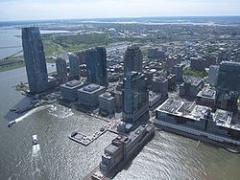
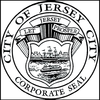
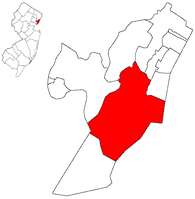
Jersey City is the seat of Hudson County, New Jersey, United States. As of the 2010 United States Census, the population of Jersey City was 247,597, making it the second-most populous city in New Jersey.
Part of the New York City metropolitan area, Jersey City lies across from Lower Manhattan between the Hudson River and Upper New York Bay and the Hackensack River and Newark Bay. A port of entry, with 11 miles (18 km) of waterfront and significant rail connections, Jersey City is an important transportation terminus and distribution and manufacturing center for the Port of New York and New Jersey. Service industries have played a prominent role in the redevelopment of its waterfront and the creation of one of the nation's largest downtowns.
Jersey City is the seat of Hudson County, New Jersey, and the second-largest city in New Jersey. According to the United States Census Bureau, the city had a total area of 21.080 square miles (54.596 km2), of which, 14.794 square miles (38.316 km2) of it is land and 6.286 square miles (16.281 km2) of it (29.82%) is water. As of the 1990 Census, it had the smallest land area of the 100 most populous cities in America.
Jersey City is bordered to the east by the Hudson River, to the north by Secaucus, North Bergen, Union City and Hoboken, to the west, across the Hackensack, by Kearny and Newark, and to the south by Bayonne. Given its proximity to Manhattan, Jersey City and Hudson County are sometimes referred to as New York City's sixth borough.
The land comprising what is now Jersey City was inhabited by the Lenape, a collection of tribes (later called Delaware Indian). In 1609, Henry Hudson, seeking an alternate route to East Asia, anchored his small vessel Halve Maen (English: Half Moon) at Sandy Hook, Harsimus Cove and Weehawken Cove, and elsewhere along what was later named the North River. After spending nine days surveying the area and meeting its inhabitants, he sailed as far north as Albany. By 1621 the Dutch West India Company was organized to manage this new territory and in June 1623, New Netherland became a Dutch province, with headquarters in New Amsterdam. Michael Reyniersz Pauw received a land grant as patroon on the condition that he would establish a settlement of not fewer than fifty persons within four years. He chose the west bank of the North River (Hudson River) and purchased the land from the Lenape. This grant is dated November 22, 1630 and is the earliest known conveyance for what are now Hoboken and Jersey City. Pauw, however was an absentee landlord who neglected to populate the area and was obliged to sell his holdings back to the Company in 1633. That year, a house was built at Communipaw for Jan Evertsen Bout, superintendent of the colony, which had been named Pavonia (the Latinized form of Pauw's name, which means peacock). Shortly after, another house was built at Harsimus Cove and became the home of Cornelius Van Vorst, who had succeeded Bout as superintendent, and whose family would become influential in the development of the city. Relations with the Lenape deteriorated, in part because of the colonialist's mismanagement and misunderstanding of the indigenous people, and led to series of raids and reprisals and the virtual destruction of the settlement on the west bank. During Kieft's War, approximately eighty Lenapes were killed by the Dutch in a massacre at Pavonia on the night of February 25, 1643.
Scattered communities of farmsteads characterized the Dutch settlements at Pavonia: Communipaw, Harsimus, Paulus Hook, Hoebuck, Awiehaken, and other lands "behind Kil van Kull". The first village (located inside a palisaded garrison) established on what is now Bergen Square in 1660, and is considered to be the oldest town in what would become the state of New Jersey.
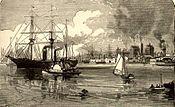
Among the oldest surviving houses in Jersey City is the stone Van Wagenen House of 1742. During the American Revolutionary War the area was in the hands of the British who controlled New York. Paulus Hook was attacked by Major Light Horse Harry Lee on August 19, 1779. After the war Alexander Hamilton and other prominent New Yorkers and New Jerseyeans attempted to develop the area that would become historic downtown Jersey City and laid out the city squares and streets that still characterize the neighborhood, giving them names also seen in Lower Manhattan or after war heroes (Grove, Varick, Mercer, Wayne, Monmouth, and Montgomery among them). During the 19th century, 60,000 former slaves reached Jersey City on one of the four routes of the Underground Railroad that led to the city.
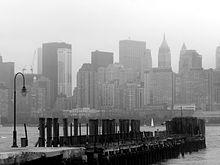
The City of Jersey was incorporated by an Act of the New Jersey Legislature on January 28, 1820, from portions of Bergen Township, while the area was still a part of Bergen County. The city was reincorporated on January 23, 1829, and again on February 22, 1838, at which time it became completely independent of North Bergen and was given its present name. On February 22, 1840, it became part of the newly-created Hudson County.
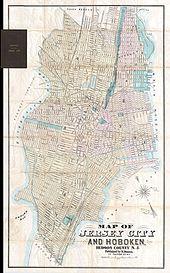
Soon after the Civil War, the idea arose of uniting all of the towns of Hudson County east of the Hackensack River into one municipality. A bill was approved by the State legislature on April 2, 1869, with a special election to be held October 5, 1869. An element of the bill provide that only contiguous towns could be consolidated. While a majority of the voters across the county approved the merger, the only municipalities that had approved the consolidation plan and that adjoined Jersey City were Hudson City and Bergen City. The consolidation began on March 17, 1870, taking effect on May 3, 1870. Three years later the present outline of Jersey City was completed when Greenville agreed to merge into the Greater Jersey City.
Jersey City was a dock and manufacturing town for much of the 19th and 20th centuries. Much like New York City, Jersey City has always been a destination for new immigrants to the United States. In its heyday before World War II, German, Irish, and Italian immigrants found work at Colgate, Chloro or Dixon Ticonderoga. However, the largest employers at the time were the railroads, whose national networks terminated on the Hudson River at Pavonia Terminal, Exchange Place and Communipaw. In 1908, the first permanent, drinking water disinfection system in the U.S. was installed on the water supply for the City by John L. Leal. The Hudson Tubes opened in 1911, allowing passengers to take the train to Manhattan as an alternative to the extensive ferry system. The Black Tom explosion occurred on July 30, 1916, as an act of sabotage on American ammunition supplies by German agents to prevent the materials from being used by the Allies in World War I.
From 1917 to 1947, Jersey City was governed by Mayor Frank Hague. Originally elected as a reform candidate, the Jersey City History Web Site says his name is "synonymous with the early twentieth century urban American blend of political favoritism and social welfare known as bossism." Hague ran the city with an iron fist while, at the same time, molding governors, United States senators, and judges to his whims. Boss Hague was known to be loud and vulgar, but dressed in a stylish manner earning him the nickname "King Hanky-Panky". In his later years in office, Hague would often dismiss his enemies as "reds" or "commies". Hague lived like a millionaire, despite having an annual salary that never exceeded $8,500. He was able to maintain a fourteen-room duplex apartment in Jersey City, a suite at the Plaza Hotel in Manhattan, and a palatial summer home in Deal, and travel to Europe yearly in the royal suites of the best liners.
After Hague's retirement from politics, a series of mayors including John V. Kenny, Thomas J. Whelan and Thomas F. X. Smith attempted to take control of Hague's organization, usually under the mantle of political reform. None were able to duplicate the level of power held by Hague, but the city and the county remained notorious for political corruption for years. By the 1970s, the city experienced a period of urban decline that saw many of its wealthy residents leave for the suburbs, rising crime, civil unrest, political corruption, and economic hardship. From 1950 to 1980, Jersey City lost 75,000 residents, and from 1975 to 1982, it lost 5,000 jobs, or 9% of its workforce.
Beginning in the 1980s, development of the waterfront in an area previously occupied by rail yards and factories helped to stir the beginnings of a renaissance for Jersey City. The rapid construction of numerous high-rise buildings increased the population and led to the development of the Exchange Place financial district, also known as 'Wall Street West', one of the largest banking centers in the United States. Large financial institutions such as UBS, Goldman Sachs, Chase Bank, Citibank and Merrill Lynch occupy prominent buildings on the Jersey City waterfront, some of which are among the tallest buildings in New Jersey. Simultaneous to this building boom, the light-rail network was developed. With 18,000,000 square feet (1,700,000 m2) of office space, it has the nation's 12th largest downtown.
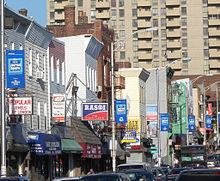
As of the 2010 United States Census, there were 247,597 people, 96,859 households, and 57,631 families residing in the city. The population density was 16,736.6 inhabitants per square mile (6,462.0 /km2). There were 108,720 housing units at an average density of 7,349.1 per square mile (2,837.5 /km2). The racial makeup of the city was 32.67% (80,885) White, 25.85% (64,002) African American, 0.51% (1,272) Native American, 23.67% (58,595) Asian, 0.07% (161) Pacific Islander, 12.81% (31,726) from other races, and 4.42% (10,956) from two or more races. Hispanic or Latino of any race were 27.57% (68,256) of the population.
There were 96,859 households out of which 27.3% had children under the age of 18 living with them, 35.5% were married couples living together, 18.2% had a female householder with no husband present, and 40.5% were non-families. 30.2% of all households were made up of individuals and 7.0% had someone living alone who was 65 years of age or older. The average household size was 2.53 and the average family size was 3.20.
In the city the age distribution of the population shows 21.1% under the age of 18, 10.0% from 18 to 24, 37.6% from 25 to 44, 22.2% from 45 to 64, and 9.0% who were 65 years of age or older. The median age was 33.2 years. For every 100 females there were 97.6 males. For every 100 females age 18 and over, there were 96.0 males.
As of the 2010 Census, Jersey City experienced an increase of 7,542 residents (3.1%) from its 2000 Census population of 240,055. Since it was believed the earlier population was under documented, the 2010 census was anticipated with the possibility that Jersey City might become the state's most populated city, surpassing Newark. The city has hired an outside firm to contest the results, citing the fact that development between 2000 and 2010 substantially increased the number of housing units and that new populations may have been undercounted. Preliminary findings indicated that 19,000 housing units went uncounted.
A 2011 survey of census data shows Jersey City to have one the nation's highest percentages of residents who work as artists, leading The Atlantic magazine to call it the 10th most artistic city in the USA.
As of the 2000 United States Census the population was 240,055 making Jersey City the 72nd most populous city in the U.S. Among cities with a population higher than 100,000 ranked in the 2000 Census, Jersey City was the fourth most densely populated large city in the United States, behind New York City, Paterson, New Jersey and San Francisco. There were 88,632 households, and 55,660 families residing in the city. The population density was 16,093.7/mi2 (6,212.2/km2). There were 93,648 housing units at an average density of 6,278.3 per square mile (2,423.4/km2). The racial makeup of the city was 34.01% White, 28.32% African American, 0.45% Native American, 16.20% Asian, 0.08% Pacific Islander, 15.11% from other races, and 5.84% from two or more races. Hispanic or Latino of any race were 28.31% of the population.
As of the 2000 Census, the most common reported ancestries were Italian (6.6%), Irish (5.6%), Polish (3.0%), Arab (2.8%), and German (2.7%).
Of all 88,632 households, 31.1% had children under the age of 18 living there, 36.4% were married couples living together, 20.2% had a female householder with no husband present, and 37.2% were non-families. 29.2% of all households were made up of individuals and 8.2% had someone living alone who was 65 years of age or older. The average household size was 2.67 and the average family size was 3.37.
In the city the population was spread out with 24.7% under the age of 18, 10.7% from 18 to 24, 35.1% from 25 to 44, 19.7% from 45 to 64, and 9.8% who are 65 years of age or older. The median age was 32 years. For every 100 females there were 95.3 males. For every 100 females age 18 and over, there were 92.6 males.
The median income of its households was $37,862, and the median income of its families was $41,639. Males had a median income of $35,119 versus $30,494 for females. The per capita income for the city was $19,410. About 16.4% of families and 18.6% of the population were below the poverty line, including 27.0% of those under age 18 and 17.5% of those age 65 or over. One of the county's three homeless shelters, Lucy's Shelter, is located in Jersey City, though a growing community of homeless have made their home outside the transit station in Journal Square.
The city is one of the most racially diverse in the world. The city's formerly most populous ethnic group, non-Hispanic white, declined from 69.5% in 1970 to 21.5% by 2010. Jersey City has a large Kenyan community, and the country's largest Egyptian Coptic population. Jersey City also has a very large Moroccan community. Indians make up a large part of the India Square district in Journal Square. Pakistanis, Guyanese, Nigerians, Vietnamese, Chinese, Haitians, Polish, Italians and the Irish also make up a large percent of the population. Jersey City also hosts a Little Manila for the large Filipino population. The city is home to 4.4% of the state aos Hispanic population, and the highest number of mixed-race residents in the county at 13%. However, relations between ethnic groups have not always been amicable, as evidenced by incidents such as the infamous Dotbusters gang attacks of 1987 against residents of South Asian descent.
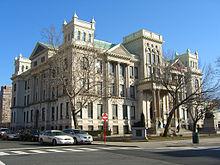
The current mayor is Jerramiah Healy, who won the special election in 2004, and was later reelected in 2005 and 2009. The current Business Administrator (BA) is John "Jack" Kelly. Kelly was nominated by Mayor Healy and was approved by the city council with a 7 ae1 vote. He started as the BA on May 18, 2010. The current City Clerk is Robert Byrne.
Jersey City is governed under the Faulkner Act (Mayor-Council) form of municipal government by a mayor and a nine-member city council. The city council consists of six members elected from wards and three elected at large, all elected to four-year terms on a concurrent basis in non-partisan elections.
The 9th, 10th, and 13th Congressional districts each contain portions of Jersey City and the city and is part of New Jersey's 31st and 33rd State Legislative Districts. In Congressional redistricting that will take effect in 2012, Jersey City will be split between the 8th and 10th Congressional Districts, one of 15 municipalities statewide to be split across two districts.
New Jersey's Ninth Congressional District is represented by Steve Rothman (D, Fair Lawn). New Jersey's Tenth Congressional District was represented by Donald M. Payne (D, Newark), until his death on March 6, 2012. New Jersey's Thirteenth Congressional District is represented by Albio Sires (D, West New York). New Jersey is represented in the United States Senate by Frank Lautenberg (D, Cliffside Park) and Bob Menendez (D, Hoboken).
The 31st District of the New Jersey Legislature is represented in the State Senate by Sandra Bolden Cunningham (D, Jersey City) and in the General Assembly by Charles Mainor (D, Jersey City) and Jason O'Donnell (D, Bayonne). The 33rd Legislative District of the New Jersey Legislature is represented in the State Senate by Brian P. Stack (D, Union City) and in the General Assembly by Sean Connors (D, Jersey City) and Ruben J. Ramos (D, Hoboken).
The city encompasses three Hudson County freeholder districts in their entirety, while three others are shared with adjacent towns.The Hudson County Executive, elected at-large, is Thomas A. DeGise. Hudson County Board of Chosen Freeholders Districts 1, 2, 3, 4, 5, and 8 are located partially or entirely in Jersey City. District 1 comprises neighboring Bayonne and a small part of Jersey City, Country Village, and is represented by Doreen McAndrew DiDomenico. District 2 includes the West Side and parts of the Marion Section and Journal Square and is represented by William O'Dea. District 3, which stretches from Paulus Hook through Bergen Hill to the east side of Greenville is represented by Jeffrey Dublin. District 4 includes Harsimus, Hamilton Park, and portions of Journal Square and the Heights and is represented by Eliu Rivera. District 5, comprising portions of the Heights and all of neighboring Hoboken, is represented by Anthony Romano. District 8 compromises all of North Bergen, the North End of Secaucus and the northern tip of the city near Transfer Station. It is represented by Thomas Liggio.
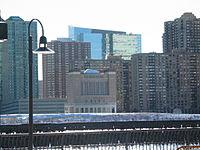
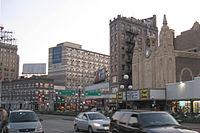
Jersey City (and most of Hudson County) is located on the peninsula known as Bergen Neck, with a waterfront on the east at the Hudson River and New York Bay and on the west at the Hackensack River and Newark Bay. Its north-south axis corresponds with the ridge of Bergen Hill, the emergence of the Hudson Palisades. The city is the site of some of the earliest European settlements in North America, which grew into each other rather expanding from central point. This growth and the topography greatly influenced the development of the sections of the city and the neighborhoods within them. The city is divided into six wards.
Downtown Jersey City is the area from the Hudson River westward to the Newark Bay Extension of the New Jersey Turnpike (Interstate 78) and the New Jersey Palisades; it is also bounded by Hoboken to the north and Liberty State Park to the south.
Newport and Exchange Place are redeveloped waterfront areas consisting mostly of residential towers, hotels and office buildings. Newport is a planned mixed-use community, built on the old Erie Lackawanna Railway yards, made up of residential rental towers, condominiums, office buildings, a marina, schools, restaurants, hotels, Newport Centre Mall, a waterfront walkway, transportation facilities, and on-site parking for more than 15,000 vehicles. Newport had a hand in the renaissance of Jersey City although, before ground was broken, much of the downtown area had already begun a steady climb (much like Hoboken). In recent years, this area of Jersey City has undergone gentrification that has seen the improvement in neighborhoods. This has also caused a rise of the standard of living throughout the city. Downtown also includes The Newport Centre area, which is also home of the Westin Hotel. Prior to the September 11 attacks Jersey City had 3 office towers over 100 meters. Since 9-11, another 3 more office towers and 10 residential buildings over 100 meters have been completed.
Bergen-Lafayette, formerly Bergen City, New Jersey, lies between Greenville to the south and McGinley Square to the north. It also borders Liberty State Park and Downtown to the east and the West Side. This area is commonly called "The Hill" by the natives of the city. Communipaw Avenue and Bergen Avenue are main thoroughfares. The former Jersey City Medical Center complex, a cluster of Art Deco buildings on a rise in the center of the city, have been converted into residential complexes called The Beacon.
The Heights or Jersey City Heights is a district in the north end of Jersey City atop the New Jersey Palisades overlooking Hoboken to the east and Croxton in the Meadowlands to the west.
The southern border of The Heights is generally considered to be north of Bergen Arches and The Divided Highway, while Paterson Plank Road in Washington Park is its main northern boundary. Transfer Station is just over the city line. Its postal area ZIP Code is 07307. The Heights mostly contains two- and three-family houses and low rise apartment buildings, and is similar to North Hudson architectural style and neighborhood character.
Previously the city of Hudson City, The Heights was incorporated into Jersey City in 1869.
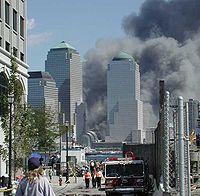
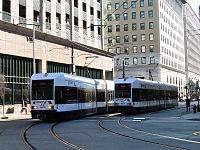
Of all Jersey City commuters, 8.17% walk to work, and 46.62% take public transit. This is the second highest percentage of public transit riders of any city with a population of 100,000+ in the United States, behind only New York City and ahead of Washington, D.C. 40.67% of Jersey City households do not own an automobile, the second-highest of all cities in the United States with 50,000 to 250,000 residents.
The Journal Square Transportation Center, Exchange Place, and Hoboken Terminal (just over the city line's northeast corner) are major origination/destination points for buses. Service is available to numerous points within Jersey City, Hudson County, and some suburban areas as well as to Newark on the 1, 2, 6, 22, 43, 64, 67, 68, 80, 81, 82, 83, 84, 85, 86, 87, 88, 123, 125, 305, 319 lines.[100] Also serving Jersey City are various lines operated by Academy Bus and A&C Bus. Increased use of jitneys, locally known as dollar vans, have greatly affected travel patterns in Hudson County, leading to decreased bus ridership on traditional bus lines. After studies examining existing systems and changes in public transportation usage patterns it was determined that a Journal Square-Bayonne bus rapid transit system should be investigated. In 2012 the Board of Chosen Freeholders authorized the identification of possible BRT corridors.[101][102][103][104][105]
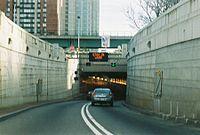
A part of the East Coast Greenway, a planned unbroken bike route from Maine to the Florida Keys, will travel through the city. Both the Hudson River Waterfront Walkway and Hackensack RiverWalk are bicycle friendly.[107]
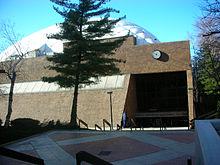
Jersey City is home to the New Jersey City University (NJCU) and Saint Peter's College, both of which are located in the city's West Side district. It is also home to Hudson County Community College, which is located in Journal Square. The University of Phoenix has a small location at Newport, and Rutgers University offers MBA classes at Harborside Center. Hudson County Community College, a junior college located in the Journal Square area offering courses to help the transition into a larger university, is praised for the culinary department and program.[108]
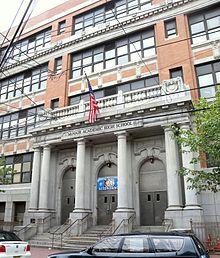
The Jersey City Public Schools serve students threeyears and older from Pre-K 3 through twelfth grade. The district is one of 31 Abbott districts statewide,[109] which are now referred to as "SDA Districts" based on the requirement for the state to cover all costs for school building and renovation projects in these districts under the supervision of the New Jersey Schools Development Authority.[110][111]
Dr. Ronald E. McNair Academic High School was the second-ranked public high school in New Jersey out of 322 schools statewide, in New Jersey Monthly magazine's September 2010 cover story on the state's "Top Public High Schools", after being ranked second in 2008 out of 316 schools.[112] and was selected as 41st best high school in the United States in Newsweek magazine's national 2011 survey.[113] William L. Dickinson High School is the oldest high school in the city and one of the largest schools in Hudson County in terms of student population. Opened in 1906 as the Jersey City High School it is one of the oldest school sites in the city, its a four-story Beaux-Arts building located on a hilltop facing the Hudson River.[114] Liberty High School (New Jersey) is also one of the top schools in the Heights and the only high school that focuses on all academics. Other public high schools in Jersey City are James J. Ferris High School, Lincoln High School, and Henry Snyder High School. The Hudson County Schools of Technology (which also has campuses in North Bergen and Secaucus) has a campus in Jersey City, which includes County Prep High School.[115]
Among Jersey City's elementary and middle schools is Academy I Middle School and Frank R. Conwell Middle School #4, which is part of the Academic Enrichment Program for Gifted Students. Another school is Alexander D. Sullivan P.S. #30, an ESL magnet school in the Greenville district, which services nearly 800 Pre-k through 5th grade students.[116]
Jersey City also has 12 charter schools, which are run under a special charter granted by the Commissioner of the New Jersey Department of Education, including the Mathematics, Engineering, Technology and Science Charter School (for grades 6 - 12) and the Dr. Lena Edwards Charter School (for K-8), which were approved in January 2011.[117]
The Roman Catholic Archdiocese of Newark maintains a network of elementary and secondary Catholic schools serve every area of Jersey City. High schools administered by the Archdiocese are Hudson Catholic Regional High School, St. Anthony High School, Saint Dominic Academy and St. Peter's Preparatory School.[118] St. Mary High School - Closed in June 2011 due to declining enrollment[119]
Catholic grade schools include Our Lady of Mercy Academy, Our Lady of Czestochowa School, Resurrection School, Sacred Heart School, St. Aloysius Elementary Academy, St. Anne School, St. Joseph School and St. Nicholas School.[120]
Other private high schools in Jersey City include First Christian Pentecostal Academy[121] and Stevens Cooperative School.[122] Kenmare High School is operated through the York Street Project as part of an effort to reduce rates of poverty in households headed by women, through a program that offers small class sizes, individualized learning and development of life skills.[123]
A number of other charter and private schools are also available. Genesis Educational Center[124] is a private Christian school located in downtown Jersey City for ages newborn through 8th grade. The Jersey City Art School is a private art school located in downtown Jersey City for all ages.[125]
The Jersey City Free Public Library has five regional branches, some of which have permanent collections and host exhibitions. At the Main Library, the New Jersey Room contains historical archives and photos. The Miller Branch is home to the Afro-American Historical and Cultural Society Museum. The Five Corners Branch specializes in works related to music and the fine arts, and is a gallery space. The library system also supports a bookmobile and five neighborhood libraries.[126]
Liberty State Park is home to Central Railroad of New Jersey Terminal, the Interpretive Center, and Liberty Science Center, an interactive science and learning center. The center, which first opened in 1993 as New Jersey's first major state science museum, has science exhibits, the world's largest IMAX Dome theater, numerous educational resources, and the original Hoberman sphere.[127] From the park, ferries travel to both Ellis Island and the Immigration Museum and Liberty Island, site of The Statue of Liberty.[128]
The Museum of Russian Art specializes in Soviet Nonconformist Art.[129]
The Jersey City Museum closed in December 2010 and is not expected to reopen. It showed contemporary work and sponsored community-oriented projects.[130]
Some stations of the Hudson Bergen Light Rail feature public art exhibitions, including those at Exchange Place, Danforth Avenue[131] and Martin Luther King Drive station.[132][133]
Jersey City has several shopping districts, some of which are traditional main streets for their respective neighborhoods, such as Central, Danforth, and West Side Avenues. Journal Square is a major commercial district. Newport Mall is a regional shopping area.[134] Portions of the city are part of an Urban Enterprise Zone. In addition to other benefits to encourage employment within the Zone, shoppers can take advantage of a reduced 3 ½% sales tax rate (versus the 7% rate charged statewide).[135]
Jersey City is home to the headquarters of Verisk Analytics[136] and Lord Abbett, a privately held money management firm.[137] Companies such as Computershare, ICAP, ADP, and Fidelity Investments also conduct operations in the city.[138] Goya Foods, which is headquartered in adjacent Secaucus, announced plans in 2011 to open a 500,000-square-foot distribution center in Jersey City.[139]
Jersey City is located within the New York media market, most of its daily papers available for sale or delivery. The daily newspaper The Jersey Journal, located at its namesake Journal Square, covers Hudson County, its morning daily, Hudson Dispatch now defunct.[140] The Jersey City Reporter is part of the Hudson Reporter group of local weeklies. The Jersey City Independent is a web-only news outlet that covers politics and culture in the city. The River View Observer is another weekly published in the city and distributed throughout the county. Another countywide weekly, El Especialito, also serves the city.[141] The Daily News maintains extensive publishing and distribution facilities at Liberty Industrial Park.[142]
WFMU 91.1FM (WMFU 90.1FM in the Hudson Valley), the longest running freeform radio station in the US, moved to Jersey City in 1998.[143] WSNR-620 AM is also licensed in the city.
Jersey City is the filming location for the 2012 reality television series Snooki & JWoww, a spinoff of Jersey Shore that stars Nicole "Snooki" Polizzi and Jennifer "JWoww" Farley living at a former firehouse at 38 Mercer Street at Grove Street in Downtown Jersey City.[144]

Word Count: 5382






